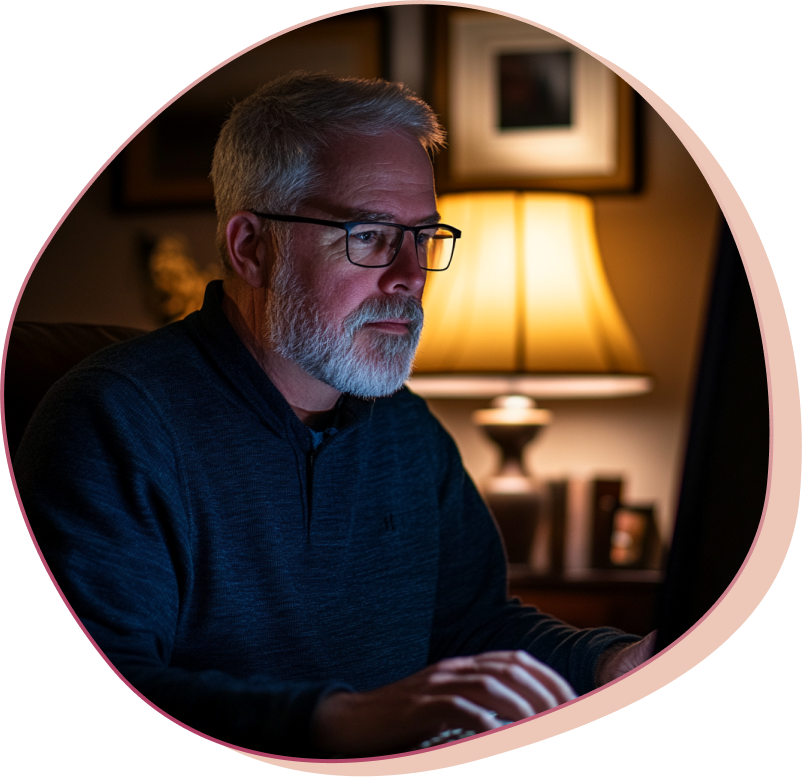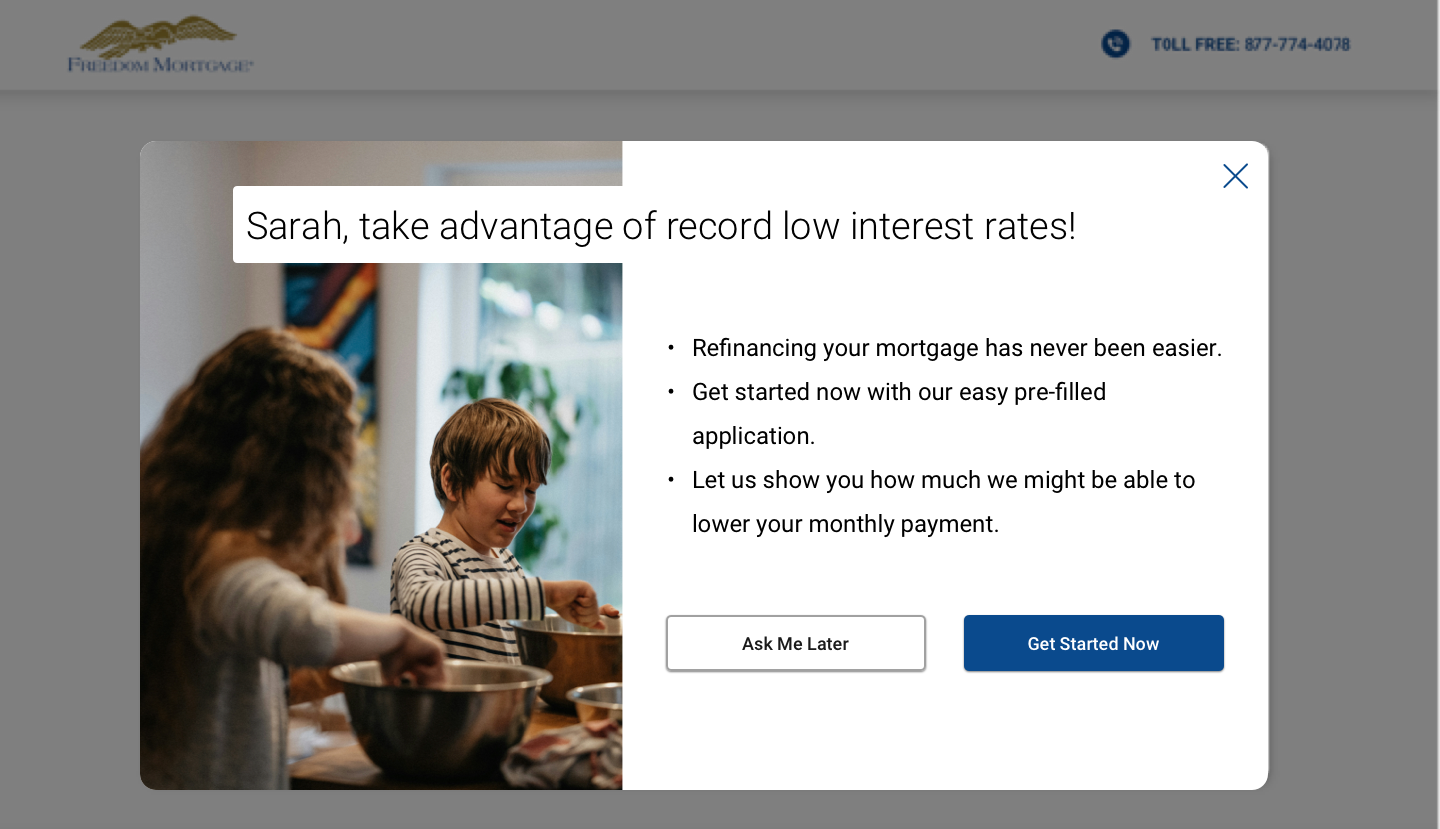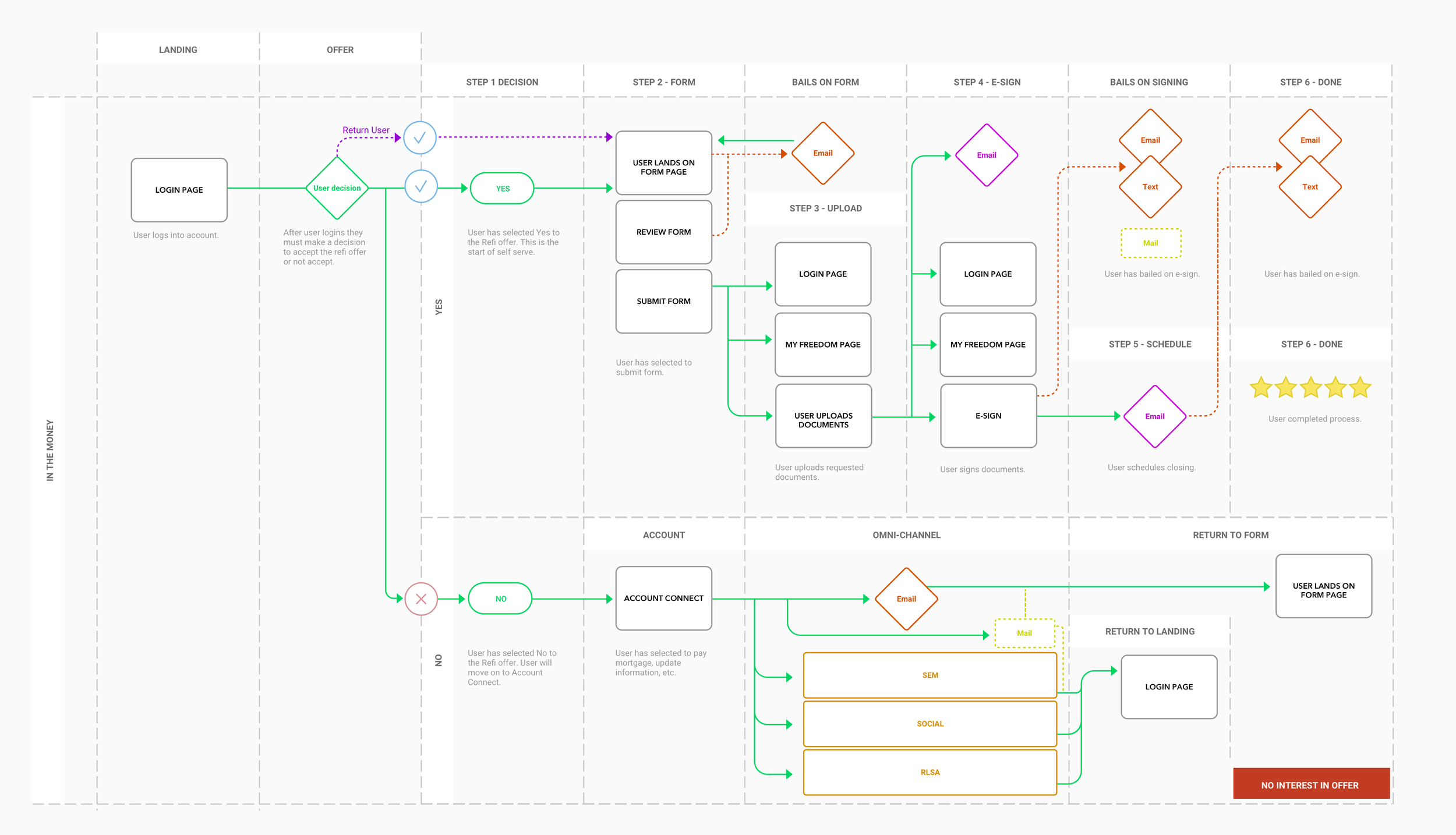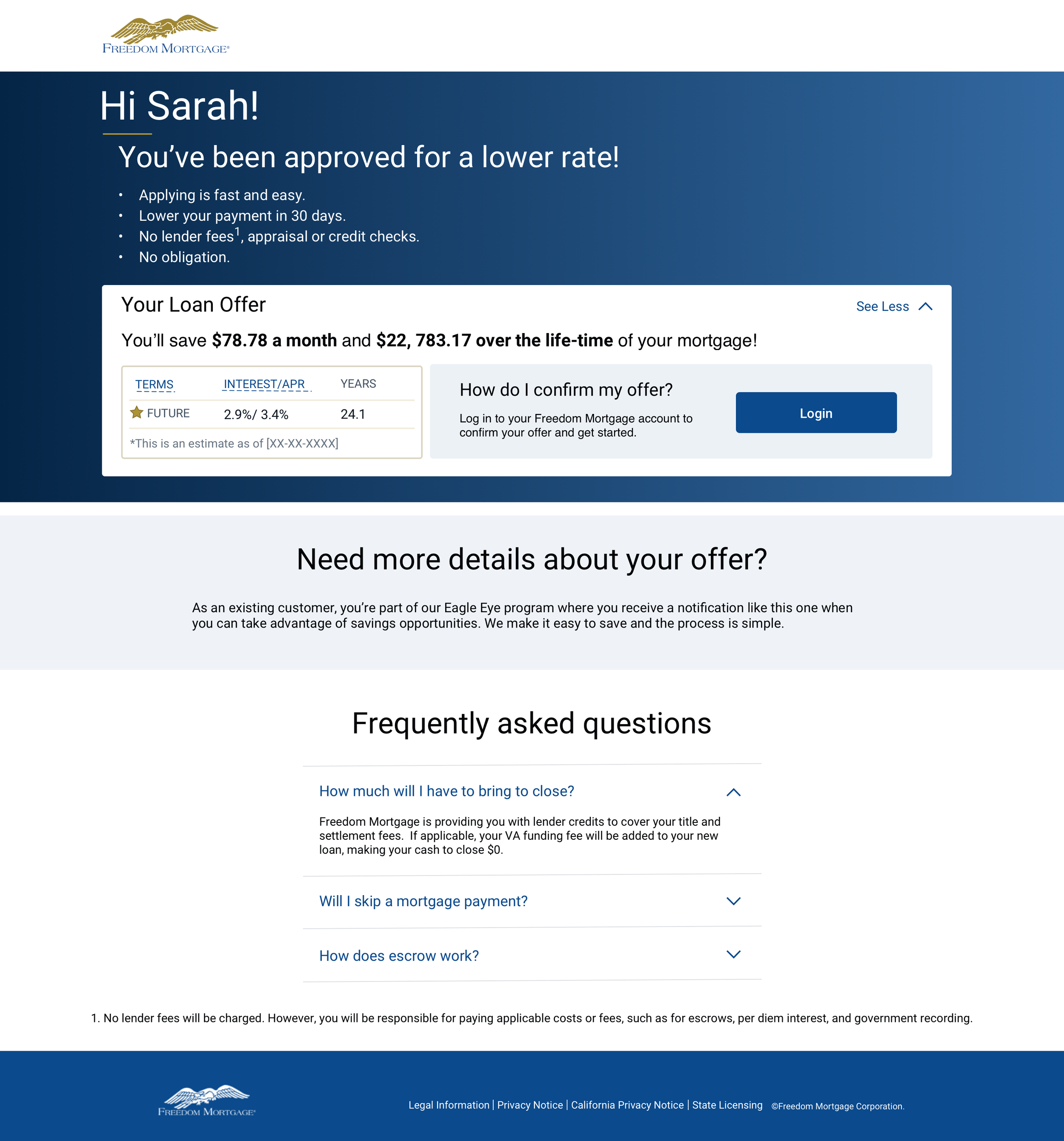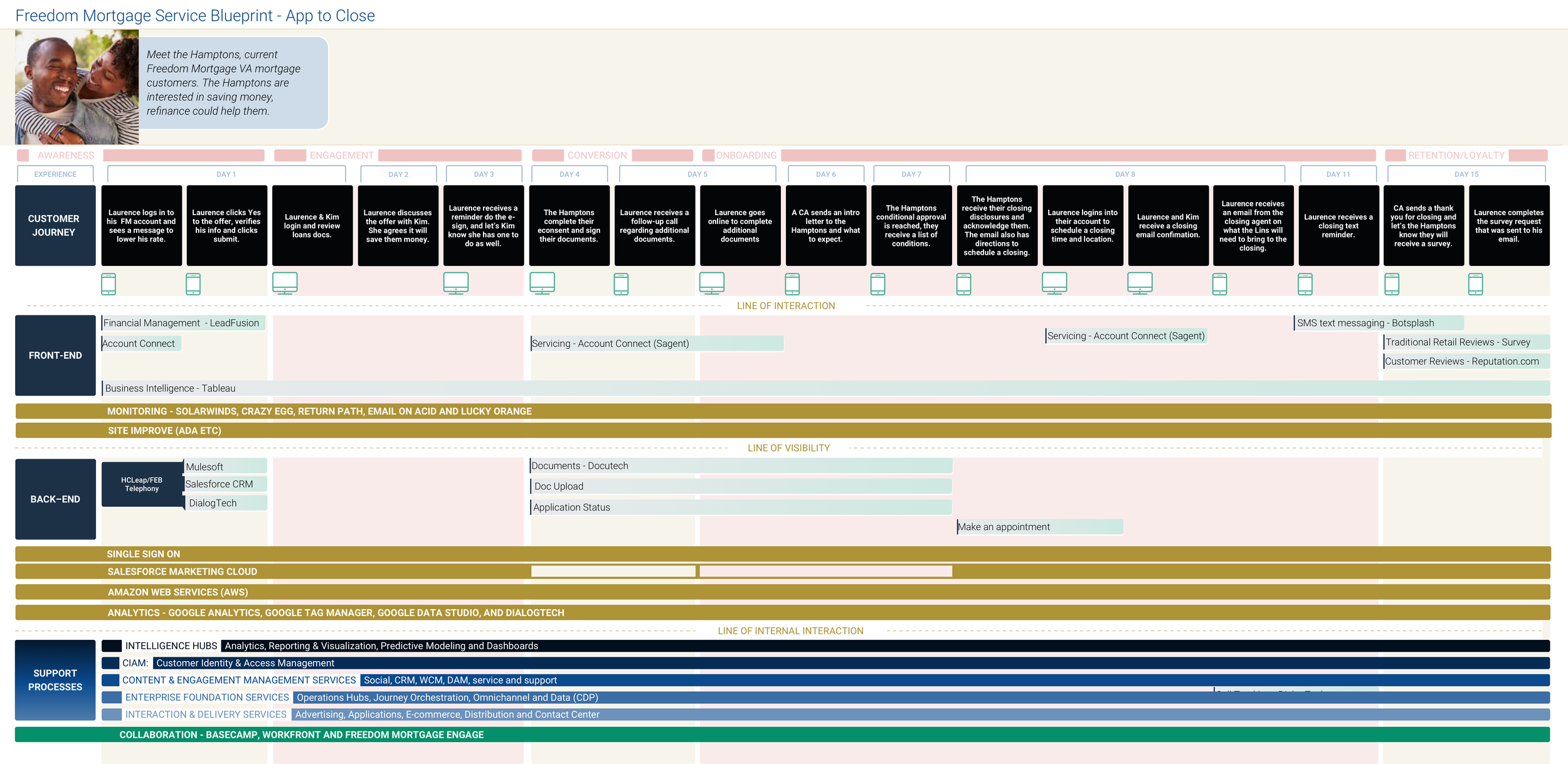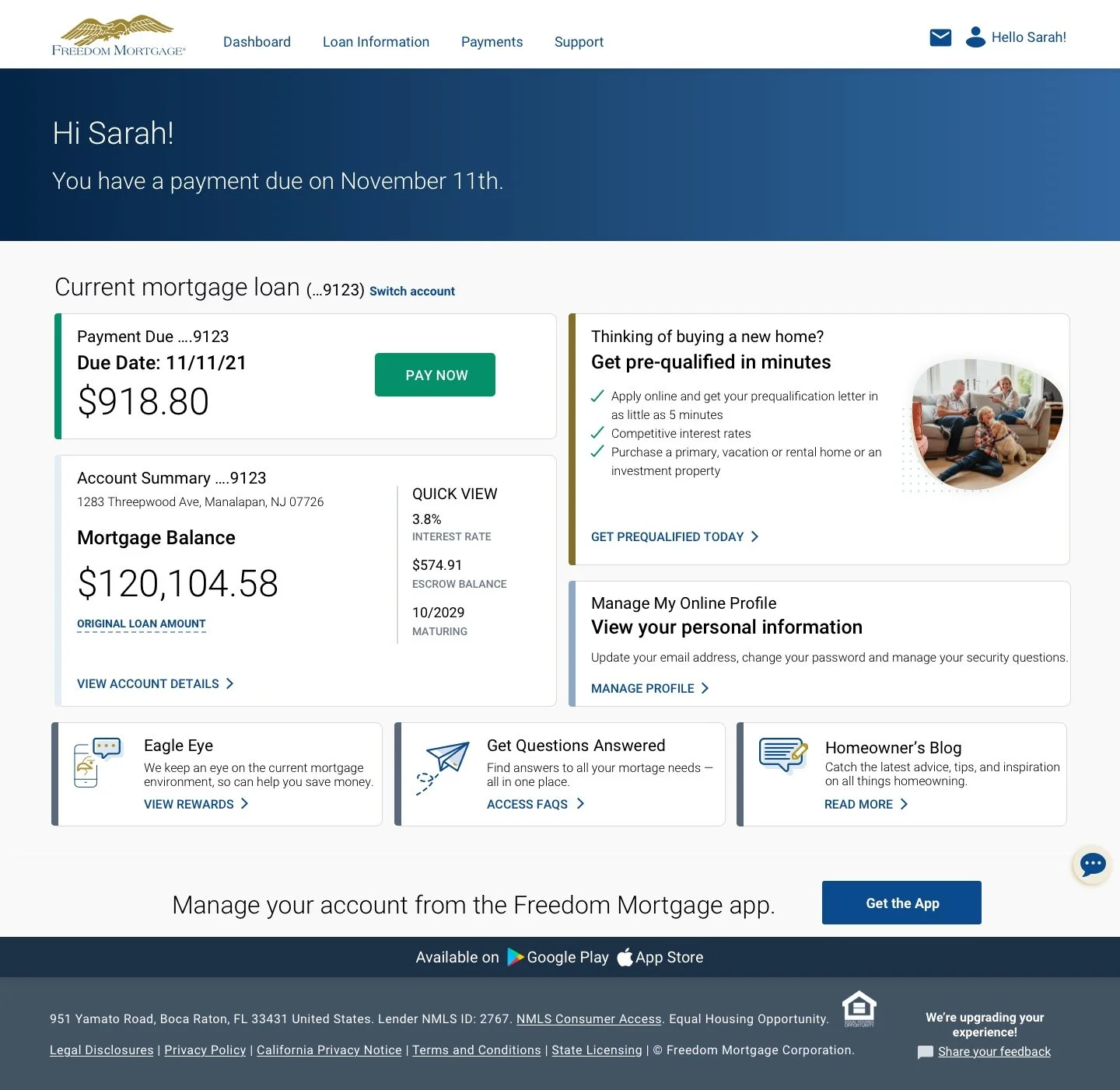Self-Service Portal
At Freedom Mortgage, I led strategy, research, and design for a self-service mortgage experience that improved user clarity and reduced friction across the loan journey. By redesigning the application and integrating proactive refinance tools, we generated $9.2M in revenue, cut call times by 50%, accelerated loan closures, and strengthened competitiveness against digital-first lenders like Rocket Mortgage.

Success Metrics
Defined and tracked performance across three key performance indicators:
Loan Process Efficiency
Goal: Reduce average mortgage closing time by 20% within 12 months.
Metric: Track days from application to closing, including approval stages and stakeholder involvement.
Tools: Google Analytics to monitor engagement and conversion behavior.
Operational Streamlining
Goal: Reduce call time during mortgage applications by 25% in 6 months, 50% in 12 months.
Metric: Measure staff involvement and average call duration post–self-service implementation.
Tools: DialogTech for call analytics.
Expected Outcome: Fewer employee errors and faster loan closures.
User Experience
Goal: Improve user control and transparency throughout the mortgage process.
Approach: Ongoing qualitative research, continuous discovery, and Qualtrics surveys.
Metrics & Targets:
User Transparency Satisfaction: 4.0
User Control Score: 4.0
Key Self-Service Actions: Enabled and tracked
Time to Complete Mortgage Online: Under 20 minutes
Design Opportunity
User Problem
The majority (80%) of borrowers preferred digital self-service over talking to a loan officer, yet Freedom Mortgage’s experience relied heavily on time-consuming phone calls and outdated processes.
This led to:
Missed expectations for tech-savvy customers (especially millennials)
Lost business to modern competitors like Better.com
Business Problem
Executives needed proof that self-service could deliver strong ROI. Despite skepticism, the business agreed to a "test-and-learn" approach to explore:
Whether users would complete mortgages online
How digital engagement could complement call center workflows
What level of investment was warranted

Team Structure & Collaboration
This initiative required executive buy-in, deep technical partnership, and strategic alignment across marketing, product, operations, and call center leadership. As the Sr. Director of XD and Research, I led both the design vision and team formation—partnering with cross-functional stakeholders to scale a single feature into an enterprise-wide experience strategy.
Core Team
Sr. Director of XD and Research - (my role)
VP of Digital Marketing
VP of Customer Experience
Frontline Development Team
SVP of Digital Marketing
SVP of Product
Key Stakeholders
Call Center - Streamline Team
EVP of Call Center
SVP of Data Marketing
Chief Knowledge Officer
Chief Marketing Officer
Chief Product Officer
Chief Executive Officer
Socialized Teams
Call Center - Shark Tank
SVP Back Office
Back End Architecture Teams
Product Teams
Key Decisions & Process
Create and Test a Proactive Self-Service Swimlane
I led the creation of a new self-service swimlane to address user confusion caused by being dropped into a refinance flow when simply trying to make a mortgage payment. As an initial intervention, I designed a modal to clarify intent and guide users down the appropriate paths. I then developed a targeted email campaign that directed users to personalized landing pages showing their refinance offers.
This streamlined approach generated $1.8M in revenue, doubling the modal test’s results in just 8% of the time. The impact captured C-suite attention and led to deeper cross-functional alignment and investment in expanding the design function.
Modal after logging in to account
Strategic decision tree developed to align messaging with the most effective communication channels
Targeted Email Campaign Driving to Personalized Offer
Personalized Offer

Operationalizing Strategy Through Service Design
To bridge fragmented systems and align executive stakeholders, I led the development of a comprehensive service blueprint that mapped the end-to-end mortgage experience.
This artifact became a strategic tool that:
Surfaced critical experience gaps and backend inefficiencies impacting both users and internal teams
Facilitated cross-functional alignment by making invisible service layers visible to product, ops, and tech stakeholders
Enabled design-led prioritization, helping leadership make informed decisions about resourcing, sequencing, and future investments
Future-State Service Blueprint Aligning Cross-Functional Vision
Redesign the Refinance Application
I led UX research, design, and A/B testing for the VA refinance application, which became the blueprint for all mortgage types across the organization. This initiative marked the company’s first fully online mortgage experience.
Results:
Drove $2.4M in revenue in the first month
Increased digital application volume and reduced call center dependency
Secured funding to scale design, adding 4 product designers, a UX researcher, and a visual designer
Scaling Experience Design Through Data-Driven Leadership
With marketing campaigns driving volume to the new VA application, I partnered with our UX researcher to identify friction points within the customer account portal through moderated and unmoderated research studies, journey mapping, and competitive analysis. As new hires from industry leaders like Mr. Cooper and Wells Fargo joined the team, I embedded continuous user research into the product lifecycle—mitigating internal bias and aligning product strategy with real user needs.
As the first designer and researcher on the initiative, I led concept development across the mortgage application, marketing touchpoints, and the self-service portal. Strong testing results and measurable impact secured stakeholder investment, allowing me to scale the team to 20, including four new designers and a roadmap for a conversational design swimlane.
Business Impact:
Delivered $9.2M in revenue by year-end
Expanded the design function to support enterprise-level growth
Built a repeatable framework aligning product vision, UX strategy, and business outcomes
Self-Service Portal

Learnings
Build Trust with Clear, Contextual Guidance
Early prototypes that lacked transparency failed to convert. Small changes, like a user-controlled modal—restored clarity and trust.
Service Design Drives Strategy
The blueprint wasn’t just a design artifact—it became a strategic tool that aligned leadership, guided staffing, and informed business planning.
Quantify to Justify
Revenue and efficiency wins gave design a seat at the table. Data-backed results convinced the C-suite to invest in a new team and platform.
Design Lead Transformation
What began as a design sprint became a catalyst for broader transformation, scaling from one feature to a 6-person experience team and a dedicated conversational design initiative.
Explore More Case Studies
Driving Business Outcomes Through Leadership
From personalization and GPS-based experiences to extended reality (XR) and enterprise-scale ecosystems, each case study highlights a unique facet of how I lead research, strategy, and user-centered solutions that drive meaningful impact.

